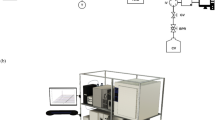Abstract
A process for enzyme-assisted extraction of polyphenols from grape pomace was developed on laboratory and pilot-plant scale. After resuspending grape pomace in water, the skins were ground and the resulting mash was pasteurized to inactivate the deteriorative enzymes responsible for polyphenol degradation, and then pre-extracted with hot water. Subsequently, cell wall polysaccharides were hydrolyzed. The extract was separated from the solid residue by pressing, and finally spray dried. Before scaling-up, enzymatic hydrolysis was optimized on laboratory scale using a D-optimal design and analyzed by response surface methodology. A mixture of pectinolytic and cellulolytic enzyme preparations (ratio 2:1) yielded the highest amounts of phenolic compounds after 2 h of treatment, applying a dosage of 4,500 mg/kg (based on dry matter) at T = 40 °C and pH 4.0. Aqueous pre-extraction of the pomace followed by enzymatic treatment resulted in significantly improved extraction yields reaching 91.9, 92.4, and 63.6% for phenolic acids, non-anthocyanin flavonoids and anthocyanins, respectively. As the yields obtained were comparable to those from sulfite-assisted extraction, this process can be considered a suitable alternative to the application of sulfite.






Similar content being viewed by others
References
FAOSTAT—FAO Statistical Database, http://www.fao.org
Famuyiwa OO, Ough CS (1990) J Agric Food Chem 38:966–968
Silva ML, Macedo AC, Malcata FX (2000) Food Sci Technol Int 6:285–300
Nurgel C, Canbas A (1998) Am J Enol Vitic 49:95–99
Braga FG, Lencart e Silva FA, Alves A (2002) Am J Enol Vitic 53:41–45
Palma M, Barroso CG (2002) Anal Chim Acta 458:119–130
Hang YD, Woodams EE (1985) Biotechnol Lett 7:253–254
Schieber A, Kammerer DR, Stintzing FC, Carle R (2002) In: Empis JA (ed) Proceedings of the international congress on pigments in food, Lisbon, Portugal, 11–14, Juni 2002, pp 87–90
Bravo L, Saura-Calixto F (1998) Am J Enol Vitic 49:135–141
Martin-Carron N, Garcia-Alonso A, Goni I, Saura-Calixto F (1997) Am J Enol Vitic 48:328–332
Valiente C, Arrigoni E, Esteban RM (1995) J Food Sci 60:818–820
Bentivegna SS, Whitney KM (2002) Food Chem Toxicol 40:1731–1743
Schieber A, Stintzing FC, Carle R (2001) Trends Food Sci Technol 12:401–413
Scalbert A, Manach C, Morand C, Remesy C, Jimenez L (2005) Crit Rev Food Sci Nutr 45:287–306
Monagas M, Hernandez-Ledesma B, Gomez-Cordoves C, Bartolome B (2006) J Agric Food Chem 54:319–327
Bocevska M, Stevcevska V (1997) Food Technol Biotechnol 35:139–143
Girard B, Mazza G (1998) In: Mazza G (ed) Functional foods. Technomic Publishing Company, Lancaster, pp 139–191
Metivier RP, Francis FJ, Clydesdale FM (1980) J Food Sci 45:1099–1100
Gastaminza G, Quirce S, Torres M, Tabar A, Echechipía S, Munoz D, Fernández De Corres L (1995) Clin Exp Allergy 25:698–703
Gruber J, St Clair L (1994) Food Aust 46:500
Adams JB (1997) Food Chem 59:401–409
Meyer AS (2002) Fruit Process 12:29–33
Meyer AS, Jepsen SM, Sørensen NS (1998) J Agric Food Chem 46:2439–2446
Kammerer DR, Claus A, Schieber A, Carle R (2005) J Food Sci 70:157–163
Kammerer DR, Claus A, Carle R, Schieber A (2004) J Agric Food Chem 52:4360–4367
Chandra A, Rana J, Li Y (2001) J Agric Food Chem 49:3515–3521
Stoll T, Schweiggert U, Schieber A, Carle R (2003) Inn Food Sci Emerg Technol 4:415–423
Düsterhöft EM, Engels FM, Voragen AGJ (1993) Bioresour Technol 44:39–46
Acknowledgments
The authors thank Felsengartenkellerei Besigheim e.G. for providing grape pomace. We are also grateful to Klaus Mix for excellent technical assistance. This research project was supported by the FEI (Forschungskreis der Ernährungsindustrie e.V., Bonn), the AiF and the Ministry of Economics and Technology, AiF-Project No.: 14039 BG.
Author information
Authors and Affiliations
Corresponding author
Rights and permissions
About this article
Cite this article
Maier, T., Göppert, A., Kammerer, D.R. et al. Optimization of a process for enzyme-assisted pigment extraction from grape (Vitis vinifera L.) pomace. Eur Food Res Technol 227, 267–275 (2008). https://doi.org/10.1007/s00217-007-0720-y
Received:
Revised:
Accepted:
Published:
Issue Date:
DOI: https://doi.org/10.1007/s00217-007-0720-y




